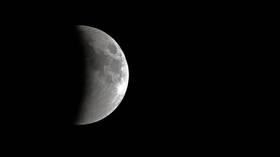Chinese mission leads to major lunar discovery

The Moon may store billions of tons of water trapped inside tiny glass spheres that are formed when asteroids hit its surface, according to a new study of lunar soil samples. The samples were retrieved during China’s 2020 robotic Chang’e-5 exploration mission.
In the study, which was published by the journal Nature Geoscience on Monday, a team of scientists claimed to have found water inside impact glass beads gathered by the Chang’e-5 lander from lunar soil.
The miniscule glass beads, which range in size from just 50 micrometers to one millimeter, usually form when an asteroid or comet crashes into the Moon, sending up molten particles which then cool down and become part of the moonscape.
The researchers believe that the beads fill with water when hit by solar winds, which carry hydrogen and oxygen from the sun across space.
“Solar wind-derived water is produced by the reaction of solar hydrogen with oxygen present at the surface of the lunar glass beads,” planetary scientist Sen Hu said.
The study also looked at water diffusion processes, estimating that the beads could be refilled with water every few years, suggesting “an efficient water recharge mechanism that could sustain the lunar surface water cycle.”
The scientists estimated that the beads could contain up to 270 billion tons of water.
Commenting on the finding, Mahesh Anand, a professor of planetary science and exploration at the Open University, described it as “one of the most exciting discoveries we’ve made,” adding that this makes “the potential for exploring the Moon in a sustainable manner” higher than ever before.
The Chang’e-5, which was China’s fifth lunar exploration mission, landed on the Moon in December 2020 and collected almost 2kg of lunar samples before safely returning to Earth later the same month.
China has an ambitious lunar program and is working toward staging a landing on the Moon before 2030. Together with Russia, it also plans to establish the International Lunar Research Station, which is expected to become operational by 2035.
In January, NASA Administrator Bill Nelson claimed that the world had found itself in “a space race” and recognized that China had achieved “enormous success and advances” in its space program.













